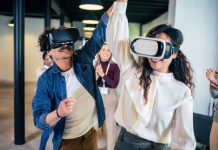
And how we became rock stars.
Maybe not stars but certainly professionals with some skills that could ease the training transition during the COVID pandemic. Quickly, online learning became a priority, especially in public health, where I work. With entire workforces, remote teleconferencing became the mother of necessity.
New training sources
Webinars
During this time, I noticed the emergence of webinars as content sources for training. Previously used mostly for information exchange and low-level learning for fans of Bloom’s Taxonomy, webinars became teaching and learning moments. As such, they came to be viewed as training. Social media and teleconferencing platforms moved to the forefront of learning.
The other group that benefited from an instructional design approach was communicators; these communicators often were subject matter experts who were recast as presenters. Some fared better than others, unleashing their inner performer, while others were more comfortable presenting the facts. In both instances, they benefited from the team approach to presenting online. It was no longer acceptable to be the person droning on, asking Bueller, Bueller? Online learning demanded interactivity beyond chat snippets.
Communicating and training became a team effort. Yes, there were presenters, but behind the curtain, a wizard ran the meeting, and subject matter experts provided the content. They quickly became adept at using the interactive features of teleconferencing platforms. Presenters became trainers, and they had to multitask. Lectures were no longer allowed.
New content could be created quickly because the form of a webinar placed time limits on presentations and a greater need to keep an audience engaged. And that audience had ever-decreasing attention spans.
Presented content could be repurposed and reused in multiple forms. A live webinar, when recorded, could become self-directed learning with the addition of assessments and tabbing. Repurposed content available online created greater scheduling flexibility. Instead of “just in time,” it could become “when one has time.”
E-learning
PowerPoint presentations and recorded webinars could be repurposed and converted to e-learning. It wasn’t enough to convert PowerPoints to e-learning, trading death by PowerPoint for death by online learning, the repurposing had to add value and interactivity. And that conversation was when instructional designers became rock stars. I’ve spent the last two years advocating for online learning, espousing the view that all communication is learning.
The most severely affected groups were those that conducted in-person training that required practiced skills. These groups would typically bring folks in for training for a few days. Bit of old school approach but valid given that those physical skills had to be practiced and ultimately assessed for competence. There was no getting around that aspect of training until they met with a rock star, aka instructional designer.
Blended learning
When informed of blended learning, these groups realized that much of their instruction could be presented online, and the hands-on practice could be delivered remotely. For instance, if learners could access the new equipment being taught, “Facetime for professionals” sessions could provide instruction and guided practice. Not ideal, but acceptable in certain situations. In public health, telemedicine is an excellent example of blended learning. Unless a patient presents with a physical ailment, a clinician can “see” a patient and develop a diagnosis based on pertinent discussion.
For these groups, one of the key points they learned in working with an instructional designer was that their 3-day sessions could be designed as a one-day in-person session, and the theoretical learning delivered online, essentially making the course’s pre-work that no one ever does, part of the actual course. JK. The other point these groups realized was that their content had to be relevant, applicable, and concise. The estimated time for the presentation could be significantly shortened. How often has in-person training dragged on because the presenter went off on tangents, addressed questions that would be covered later, and bonded with learners, which led to personal anecdotes shared and stories told?
A true rock star knows people come to hear the hits. So, get on with it.




